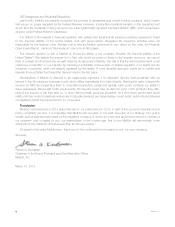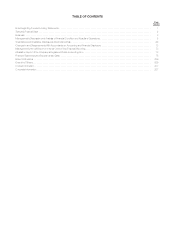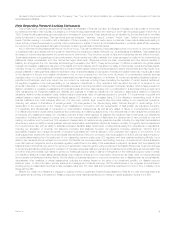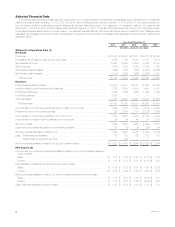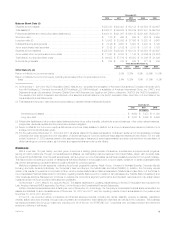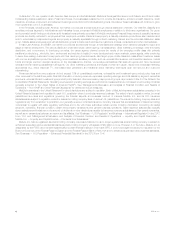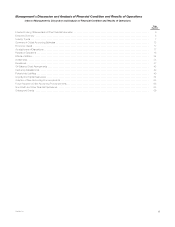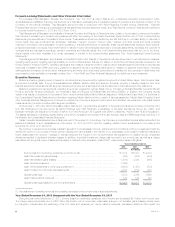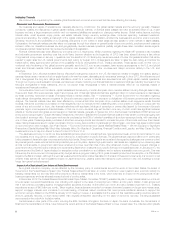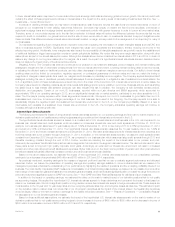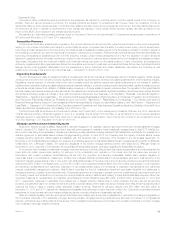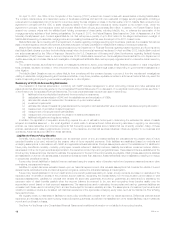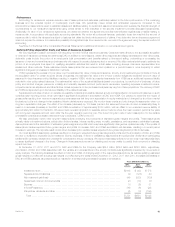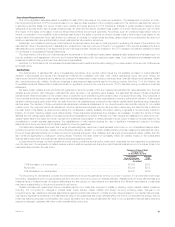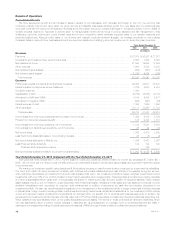MetLife 2012 Annual Report Download - page 15
Download and view the complete annual report
Please find page 15 of the 2012 MetLife annual report below. You can navigate through the pages in the report by either clicking on the pages listed below, or by using the keyword search tool below to find specific information within the annual report.to lower interest rates was in response to concerns about Europe’s sovereign debt crisis and slowing global economic growth. We cannot predict with
certainty the effect of these programs and policies on interest rates or the impact on the pricing levels of risk-bearing investments at this time. See “—
Investments — Current Environment.”
In periods of declining interest rates, we may have to invest insurance cash flows and reinvest the cash flows we received as interest or return of
principal on our investments in lower yielding instruments. Moreover, borrowers may prepay or redeem the fixed income securities, commercial or
agricultural mortgage loans and mortgage-backed securities in our investment portfolio with greater frequency in order to borrow at lower market rates.
Therefore, some of our products expose us to the risk that a reduction in interest rates will reduce the difference between the amounts that we are
required to credit on contracts in our general account and the rate of return we are able to earn on investments intended to support obligations under
these contracts. This difference between interest earned and interest credited, or margin, is a key metric for the management of, and reporting for, many of
our businesses.
Our expectations regarding future margins are an important component impacting the amortization of certain intangible assets such as DAC and
value of business acquired (“VOBA”). Significantly lower margins may cause us to accelerate the amortization, thereby reducing net income in the
affected reporting period. Additionally, lower margins may also impact the recoverability of intangible assets such as goodwill, require the establishment
of additional liabilities or trigger loss recognition events on certain policyholder liabilities. We review this long-term margin assumption, along with other
assumptions, as part of our annual assumption review. Although the analysis shown below considers low interest rates in 2013 and 2014, it does not
assume any change to our long-term assumption for margins. As a result, the impact of a hypothetical interest rate stress scenario described below
does not capture the impact of any of the aforementioned items.
Mitigating Actions. The Company has been and continues to be proactive in its investment strategies, product designs, and interest crediting rate
strategies to mitigate the risk of unfavorable consequences from the low interest rate environment. Lowering interest crediting rates on some products,
or adjusting the dividend scale on traditional products, can help offset decreases in investment margins on some products. Our ability to lower interest
crediting rates could be limited by competition, regulatory approval, or contractual guarantees of minimum rates and may not match the timing or
magnitude of changes in asset yields. As a result, our margins could decrease or potentially become negative. The Company applies disciplined ALM
strategies, including the use of derivatives, primarily interest rate swaps, floors and swaptions, to mitigate the risk of sustained low interest rates in the
U.S. A significant portion of these derivatives were entered into prior to the onset of the current low U.S. interest rate environment. In some cases, the
Company has entered into offsetting positions as part of its overall ALM strategy and to reduce volatility in net income. Business actions, such as shifting
the sales focus to less interest rate sensitive products, can also mitigate this risk. In addition, the Company is well diversified across product,
distribution, and geography. Certain of our non-U.S. businesses, reported within our Latin America and EMEA segments, which accounted for
approximately 15% of our operating earnings in 2012, are not significantly interest rate or market sensitive, particularly to any direct sensitivity to U.S.
rates. The Company’s primary exposure within these segments is insurance risk. We expect our non-U.S. businesses to grow faster than our U.S.
businesses and, over time, to become a larger percentage of our total business. As a result of the foregoing, the Company expects to be able to
substantially mitigate the negative impact of a sustained low interest rate environment in the U.S. on the Company’s profitability. Based on a near to
intermediate term analysis of a sustained lower interest rate environment in the U.S., the Company anticipates operating earnings will continue to
increase, although at a slower growth rate.
Interest Rate Stress Scenario
The following summarizes the impact of a hypothetical interest rate stress scenario on our operating earnings and the mark-to-market impact of our
derivative positions that do not qualify as accounting hedges assuming a continued low interest rate environment in the U.S.
The hypothetical interest rate stress scenario is based on a constant set of U.S. interest rates and credit spreads in the U.S., as compared to our
business plan interest rates and credit spreads, which are based on consensus interest rate view and credit spreads as of October 31, 2012. For
example, our business plan assumes a 10-year treasury rate of 1.69% at December 31, 2012 to rise during 2013 to 2.38% by December 31, 2013
and remain at 2.38% until December 31, 2014. The hypothetical interest rate stress scenario assumes the 10-year treasury rate to be 1.69% at
December 31, 2012 and remain constant at that level until December 31, 2014. We make similar assumptions for interest rates at other maturities, and
hold this interest rate curve constant through December 31, 2014. In addition, in the interest rate stress scenario, we assume credit spreads remain
constant from December 2012 through the end of 2014, as compared to our business plan which assumes rising credit spreads through 2013 and
thereafter remaining constant through the end of 2014. Further, we also are including the impact of low interest rates on our pension and post-
retirement plan expenses. We allocate this impact across our segments; it is included in the segment discussion below. The discount rate used to value
these plans is tied to long-term high quality corporate bond yields. Accordingly, an extended low interest rate environment will result in increased
pension and other post-retirement benefit liabilities and expenses. Higher total return on the fixed income portfolio of pension and other post-retirement
benefit plan assets will partially offset this increase in pension and other post-retirement plan liabilities.
Based on the above assumptions, we estimate the impact of the hypothetical U.S. interest rate stress scenario on our consolidated operating
earnings to be a decrease of approximately $45 million and $150 million in 2013 and 2014, respectively.
As previously mentioned, operating earnings is the measure of segment profit and loss that we use to evaluate segment performance and allocated
resources. Further, we believe the presentation of operating earnings and operating earnings available to common shareholders as we measure it for
management purposes enhances the understanding of our performance by highlighting the results of operations and the underlying profitability drivers of our
business. The most directly comparable GAAP measure is not accessible on a forward-looking basis because we believe it is not possible to provide other
than a range of net investment gains and losses and net derivative gains and losses, which can fluctuate significantly within or outside the range from period to
period and may have a significant impact on GAAP net income. See “— Non-GAAP and Other Financial Disclosures” for definitions of such measures.
In addition to the impact on operating earnings, we estimated the effect on the mark-to-market impact of our derivative positions that do not qualify
as accounting hedges. We applied the hypothetical U.S. interest rate stress scenario to these derivatives and compared the impact to that based on
rates in our business plan. We hold a significant position in long duration receive-fixed interest rate swaps to hedge reinvestment risk. These swaps are
most sensitive to the 30-year and 10-year swap rates and we recognize gains as rates drop and recognize losses as rates rise. This estimated impact
on the derivative mark-to-market does not include that of our VA program derivatives as the impact of low interest rates in the freestanding derivatives
would be largely offset by the mark-to-market in earnings for the related embedded derivative. See “— Results of Operations — Consolidated Results”
for discussions on our net derivative gains and losses.
Based on these additional assumptions, we estimate the impact of the hypothetical U.S. interest rate stress scenario on the mark-to-market of our
derivative positions that do not qualify as accounting hedges to be an increase in income of $450 million to $850 million and a decrease in income of
$200 million to an increase in income of $200 million in 2013 and 2014, respectively.
MetLife, Inc. 9


